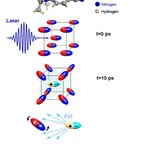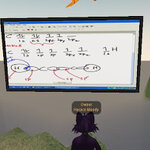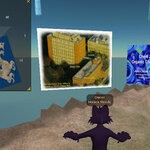Chemistry
We deal with ice every day. Yet we don't all there is to know about it. Now Dr Angelos Michaelides and Professor Karina Morgenstern say they have made a breakthrough in understanding how ice works.
Dr Michaelides said, “We are all familiar with the freezing of water. It features prominently in our daily lives, from fridge freezers to winter snow. Despite all this, the question of how individual water molecules come together and give birth to ice crystals remains mysterious.”
Understanding the process of ice nucleation at a molecular level also takes us a step closer to understanding the…

University of Nottingham scientists have been instrumental in helping to establish a pioneering branch of chemistry in Ethiopia.
They have helped to introduce Green Chemistry, an emerging field of sustainable science that will help African nations to meet the challenges of the 21st century.
Green Chemistry focuses on greener ways of creating chemicals, and is now regarded as one of the major routes to more environmentally-friendly production of the chemicals that underpin modern society.
The work of Nottingham academics with their colleagues in Ethiopia began with a chance meeting four years…

In a "2007 Hot Article" of the journal Biochemistry, University at Buffalo chemists report the discovery of a central mechanism responsible for the action of the powerful biological catalysts known as enzymes.
The UB research provides critical insight into why catalysis is so complex and may help pave the way for improving the design of synthetic catalysts.
“The more that is known about catalysis, the better chances we have of designing active catalysts,” said John P. Richard, Ph.D., professor of chemistry in the UB College of Arts and Sciences and co-author of the paper with Tina L. Amyes…

Here are some figures that Al Gore doesn’t mention in his “Inconvenient Truth”:
BTUs needed to raise earth’s atmosphere 1 degree F: 1.18 x 10 19 BTU
BTUs consumed by US economy per day: 2.7 x 10 14 BTU
BTUs produced by the sun to raise the earth’s atmosphere 20 degrees F each day: 2.2 x 10 20 BTU
BTUs radiated back into space as infrared heat energy every day: All of the above.
CO2 already in the earth’s atmosphere = 5.9 x 10 17 lbs.
CO2 produced yearly in US by burning gasoline = 5.88 x 10 9 lbs. One part in 100 million already there.
Number of degrees Celsius needed to double the CO2 in…

Ultrafast intramolecular electronic charge separation during photo-chemical reactions cause up to tenthousand surrounding molecules to perform aligning pirouettes. Researchers observed for the first time such light induced reorientations in an organic molecular crystal.
In their study they initiated a separation of positive and negative electronic charge in a small number of particular molecules with extremely short light pulses. In turn the surrounding molecules responded by aligning their respective dipole axes along the photoinduced electric fields. The researchers observed this…
Sandia National Laboratories is pioneering the future of superalloy materials by advancing the science behind how those superalloys are made.
As part of Sandia’s nanoscale research, a group of experts specializing in inorganic synthesis and characterization, modeling, and radiation science have designed a radical system of experiments to study the science of creating metal and alloy nanoparticles.
CLICK IMAGE FOR FULL SIZE.Single gold nanoparticle crystals formed using radiolysis at Sandia’s Gamma Irradiation Facility (approximately 30 nm in size). Credit: Sandia
This research has vast…

Before life emerged on earth, either a primitive kind of metabolism or an RNA-like duplicating machinery must have set the stage – so experts believe. But what preceded these pre-life steps?
A pair of UCSF scientists has developed a model explaining how simple chemical and physical processes may have laid the foundation for life. Like all useful models, theirs can be tested, and they describe how this can be done. Their model is based on simple, well-known chemical and physical laws.
The basic idea is that simple principles of chemical interactions allow for a kind of natural selection on a…

We met with the librarians today and Beth gave them movie screens that play on Second Life. I also got to put a few of my lectures from CHEM241, introductory organic chemistry in the chemistry area.
Since I already have a blog used for vodcasting with files in m4v format, all I had to do is put links to those files in Second Life. The screen is placed between the quiz obelisks on the left and the UsefulChem project on the right. Although it is more convenient to view lectures from the vodcast or blog because they can be paused or rewinded there, one of the objectives here is to show…
With a nod to one of nature's best surface chemists—an obscure desert beetle—polymer scientists at the National Institute of Standards and Technology (NIST) have devised a convenient way to construct test surfaces with a variable affinity for water, so that the same surface can range from superhydrophilic to superhydrophobic, and everything in between. Their technique, reported in a recent issue of the journal Langmuir,* may be used for rapid evaluation of paints and other materials that need to stick to surfaces.
Wetability gradient: Water sprayed on a glass slide coated with a…

Based on a suggestion by Beth and a rapid implementation by Eloise, the terrain of Drexel Island on Second Life is now shaped like the Drexel dragon mascot. That makes it pretty convenient to specify where things are located.
I started with the dragon's head to create a little section for the chemistry department, showing a picture of our building and adding some info as a note attached to the image. Clicking on the image opens a browser window to the department website.
This is also where I put the obelisks that my students in my organic chemistry class CHEM241 can use for quizzing.
Because…